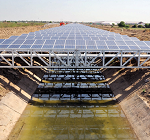Since January 2015, SunEdison, a U.S.-headquartered solar energy firm, has announced three major projects with a total capacity to generate 12 gigawatts of electricity in the states of Rajasthan, Gujarat, and Karnataka. The spate of announcements follows the October 2014 decision by the Indian government to revise its target of generating electricity through clean energy—100 gigawatts from solar power by 2022 under the National Solar Mission. Recognising the opportunity, global solar companies are eager to tap into India’s renewable energy market.
 Pashupathy Gopalan, president, Asia Pacific, of SunEdison, talks to Gateway House about the emerging solar energy landscape in India, and the opportunities created by the government’s clean energy policy.
Pashupathy Gopalan, president, Asia Pacific, of SunEdison, talks to Gateway House about the emerging solar energy landscape in India, and the opportunities created by the government’s clean energy policy.
Q. What are your views on the U.S.’s promise to finance the transition of developing countries to clean fuel technology?
The U.S. government, through its U.S.-EXIM, is involved in, and actively pushing, the renewable energy sector of many countries. As an entity involved in the sector, I am glad that the Obama administration is taking this initiative; this boost will help developing countries. The announcement is also good news for the global clean energy initiative.
Q. The India-U.S. disagreement on intellectual property rights (IPR) for solar technology is contrary to the U.S.’s commitment to climate change. If the U.S. wants developing countries like India to meet tangible climate change targets by reducing carbon emissions, doesn’t over-pricing of solar technology through IPR amount to arm-twisting?
The solar technology coming from the U.S. may be slightly more expensive because the labour costs are higher. Different countries have different labour costs, and because the U.S. has high salaries in its factories, this cost difference is reflected in the price of the end-product. Other options are also available to India—OPEC funding for photovoltaic (PV), for example, does not require buying any American content.
However, if India is opting for U.S.-EXIM funding, which mandates that the product used is of American origin, then this funding is being made available at a very low interest rate. Even though the initial cost is high because you are essentially buying expensive equipment, the end-cost is more or less the same.
Q. SunEdison and Adani Group have recently announced a deal for setting up a PV manufacturing facility with a $4 billion investment. Can you tell us about this project?
We are looking at setting up a polysilicon module in India. The polysilicon itself will be of 5 gigawatts capacity, and module capacities can be added as we go along. Initially, we are looking at setting up 1-2 gigawatts of capacity. We will be using monocrystalline technology to manufacture the PV cells. At the moment our aim is to finalise the agreement by the middle of 2015 and set up the facility within a time-frame of three years.
Q. By 2030, 70 cities in India are likely to have a population of more than 1 million—this is a potentially huge consumer market for solar rooftop installations. What are the main challenges of entering this market?
Our main challenge in India is consistency of policy. When the government rolls out a policy, consistency is necessary, instead of a changing stand and varying methods every six months or one year.
For example, SunEdison built two power plants in 2012 in Rajasthan and did some bundling of power with the National Thermal Power Corporation (NTPC), after which the Indian government allowed viability gap funding and then introduced new mechanisms that we had to follow. So all we ask for is consistency in policy and its implementation.
Q. How does the cost of solar power compare with a clean fuel like natural gas—especially after fossil fuel prices have fallen sharply in the last six months?
In the Indian context, the fluctuations and drop in fossil fuel prices do not affect us because this fuel is not used to produce electricity, like solar panels are. Our projections show that solar markets will grow and are set to become big, and will not really be impacted by the recent drop in crude oil prices.
Q. With industrial output expected to grow in India in the coming years, will it be better to have a large, central power plant powered by natural gas, or are incremental, scalable investments in solar a better option?
 Gas is cheap, but it is not easily available in India, and the import and infrastructure costs certainly don’t make it cheap when it is finally available for power generation. In India’s case, therefore, we have to look at what resource is available, and what role solar, wind, and traditional fuels like coal can play in power generation capacity.
Gas is cheap, but it is not easily available in India, and the import and infrastructure costs certainly don’t make it cheap when it is finally available for power generation. In India’s case, therefore, we have to look at what resource is available, and what role solar, wind, and traditional fuels like coal can play in power generation capacity.
In this context, a lot of solar power production facilities can, and will be, built. In 2014, over 55% of the power generation capacity built was from solar power. So even if fossil fuel prices are low right now, they require a lot of infrastructure to support its usage—solar is relatively low cost on all fronts, and it is the future.
Pashupathy Gopalan, is President, Asia Pacific, SunEdison.
This interview was exclusively conducted for Gateway House: Indian Council on Global Relations. You can read more exclusive content here.
For interview requests with the author, or for permission to republish, please contact outreach@gatewayhouse.in.
© Copyright 2014 Gateway House: Indian Council on Global Relations. All rights reserved. Any unauthorized copying or reproduction is strictly prohibited.


